Powder Metallurgy: A New Path for Advanced Titanium Alloys in the EU Medical Device Supply Chain
Abstract
1. Introduction
2. The PM Path in the EU Titanium Alloy Supply Chain
3. Advance Titanium Alloys for Next-Generation Implants
4. High-Performance Titanium Materials Produced on the PM Route
4.1. Mechanical Alloying
4.2. Hot Isostatic Pressing
4.3. Thermo-Mechanical Deformations
4.4. Equal Channel Angular Pressing
4.5. Oxygen Content
4.6. Heat Treatments
5. New Path on the EU Industry through the Resilience PM Supply Chain
Author Contributions
Funding
Data Availability Statement
Conflicts of Interest
References
- Affairs, F. The Ageing Report Economic & Budgetary Projections for the 28 EU Member States (2016–2070). Inst. Pap. 2018, 79, 25. [Google Scholar] [CrossRef]
- National Center for Health Statistics. Health, United States, With Special Feature on Adults Aged 55–64; DHHS Publication: Hyattsville, MD, USA, 2015; No 2015-1232.
- Anon. World Preview 2018, Outlook to 2024. Evaluate Pharma, June. 2018. Available online: http://info.evaluategroup.com/rs/607-YGS-364/images/WP2018.pdf (accessed on 28 November 2019).
- Study on the review of the list of Critical Raw Materials Criticality Assessments. In Directorate-General for Internal Market, Industry, Entrepreneurship and SMEs Directorate Industrial Transformation and Advanced Value Chains Unit C.2—Resource Efficiency and Raw Materials; European Commission: Luxembourg, 2017; ISBN 978-92-79-47937-3. [CrossRef]
- Reade. Reade International Corp., Titanium Metal (Ti)/Sponge/Titanium Powder. 2019 (Reade International Corp., Riverside, RI 02915 USA). Available online: https://www.reade.com/products/titanium-metal-ti-sponge-titanium-powder (accessed on 28 November 2019).
- DERA. Pricelist of Raw Materials. 2019. Available online: https://www.bgr.bund.de/DE/Themen/Min_rohstoffe/Produkte/produkte_node.html?tab=Rohstoffpreise (accessed on 7 July 2019).
- U.S. Bureau of Labor Statistics. Producer Price Index by Commodity: Metals and Metal Products: Titanium and Titanium-Base Alloy Mill Shapes [WPU102505], Retrieved from FRED, Federal Reserve Bank of St. Louis. Available online: https://fred.stlouisfed.org/series/WPU102505 (accessed on 28 December 2022).
- Lario-femenía, J.; Amigó-mata, A.; Vicente-escuder, Á.; Segovia-lópez, F. Desarrollo de las aleaciones de titanio y tratamientos superficiales para incrementar la vida útil de los implantes. Rev. De Metal. 2016, 52, e084–e096. [Google Scholar] [CrossRef]
- Joseph, G.; U.S. Geological Survey. Titanium and titanium dioxide 1. World 2011, 1, 172–173. Available online: https://www.usgs.gov/centers/national-minerals-information-center/titanium-statistics-and-information (accessed on 28 November 2019).
- Mellor, I.; Doughty, G. Novel and emerging routes for titanium powder production-an overview. Key Eng. Mater. 2016, 704, 271–281. [Google Scholar] [CrossRef]
- Froes, F.H.; Gungor, M.N.; Ashraf Imam, M. Cost affordable titanium—An update. TMS Annu. Meet. 2007, 7857, 3–12. [Google Scholar] [CrossRef]
- Fang, Z.Z.; Paramore, J.D.; Sun, P.; Chandran KS, R.; Zhang, Y.; Xia, Y.; Cao, F.; Koopman, M.; Free, M. Powder metallurgy of titanium–past, present, and future. Int. Mater. Rev. 2018, 63, 407–459. [Google Scholar] [CrossRef]
- Fang, Z.Z.; Sun, P. Pathways to optimize performance/cost ratio of powder metallurgy titanium—A perspective. Key Eng. Mater. 2012, 520, 15–23. [Google Scholar] [CrossRef]
- Li, Y.; Yang, C.; Zhao, H.; Qu, S.; Li, X.; Li, Y. New developments of ti-based alloys for biomedical applications. Materials 2014, 7, 1709–1800. [Google Scholar] [CrossRef]
- Dobrzańska, J.; Dobrzański, L.B.; Dobrzański, L.A.; Dobrzańska-Danikiewicz, A.D.; Gołombek, K. What are the chances of resilon to dominate the market filling materials for endodontics? Metals 2021, 11, 1744. [Google Scholar] [CrossRef]
- Abkowitz, S.M.; Abkowitz, S.; Fisher, H. Breakthrough claimed for titanium PM. Met. Powder Rep. 2011, 66, 16–21. [Google Scholar] [CrossRef]
- Torralba, J.M.; Campos, M. Toward high performance in Powder Metallurgy. Rev. De Metal. 2014, 50, 1–13. [Google Scholar] [CrossRef]
- Wu, J.; Zhu, G.; Feng, P.; Zhou, X.; Wang, X.; Akhtar, F. Formation of Mo−Si−Ti Alloys by Self—Propagating Combustion Synthesis. Mater. Res. 2015, 18, 806–812. [Google Scholar] [CrossRef]
- Sytschev, A.E.; Kamynina, O.K.; Umarov, L.M.; Shchukin, A.S.; Vadchenko, S.G. Porous Ti–Co alloys and their joining with titanium by SHS cladding. Int. J. Self-Propagating High-Temp. Synth. 2015, 24, 171–173. [Google Scholar] [CrossRef]
- Adams, J.W.; Chin, E.; Roy, W.; Moxson, V.S.; Duz, V.; Deters, J.; Niese, C.; Suminski, C. Billets for Making Appliqué Armor Attachments; 26th Army Science Conference: Orlando, FL, USA, 2003. [Google Scholar]
- Rack, H.J.; Qazi, J.I. Titanium alloys for biomedical applications. Mater. Sci. Eng. C 2006, 26, 1269–1277. [Google Scholar] [CrossRef]
- Niinomi, M. Mechanical biocompatibilities of titanium alloys for biomedical applications. J. Mech. Behav. Biomed. Mater. 2008, 1, 30–42. [Google Scholar] [CrossRef]
- Eisenbarth, E.; Velten, D.; Müller, M.; Thull, R.; Breme, J. Biocompatibility of β-stabilizing elements of titanium alloys. Biomaterials 2004, 25, 5705–5713. [Google Scholar] [CrossRef] [PubMed]
- Long, M.; Rack, H.J. Titanium alloys in total joint replacement—A materials science perspective. Biomaterials 1998, 19, 1621–1639. [Google Scholar] [CrossRef] [PubMed]
- Liu, Y.; Chen, L.F.; Tang, H.P.; Liu, C.T.; Liu, B.; Huang, B.Y. Design of powder metallurgy titanium alloys and composites. Mater. Sci. Eng. A 2006, 418, 25–35. [Google Scholar] [CrossRef]
- Romero, C.; Yang, F.; Bolzoni, L. Fatigue and fracture properties of Ti alloys from powder-based processes—A review. Int. J. Fatigue 2018, 117, 407–419. [Google Scholar] [CrossRef]
- Nazari, K.A.; Nouri, A.; Hilditch, T. Effects of milling time on powder packing characteristics and compressive mechanical properties of sintered Ti-10Nb-3Mo alloy. Mater. Lett. 2015, 140, 55–58. [Google Scholar] [CrossRef]
- Zadra, M. Mechanical alloying of titanium. Mater. Sci. Eng. A 2013, 583, 105–113. [Google Scholar] [CrossRef]
- Bolzoni, L.; Ruiz-Navas, E.M.; Zhang, D.; Gordo, E. Modification of sintered titanium alloys by hot isostatic pressing. Key Eng. Mater. 2012, 520, 63–69. [Google Scholar] [CrossRef]
- Samarov, V.; Seliverstov, D.; Froes, F.H. Fabrication of near-net-shape cost-effective titanium components by use of prealloyed powders and hot isostatic pressing. In Titanium Powder Metallurgy: Science, Technology and Applications; Elsevier Inc.: Amsterdam, The Netherlands, 2015. [Google Scholar] [CrossRef]
- Ahlfors, M.; Hjärne, J.; Shipley, J. Cost effective Hot Isostatic Pressing. In A Cost Calculation Study for AM Parts; Quintus Technologies: Lewis Center, OH, USA, 2018. [Google Scholar]
- Lario, J.; Vicente, Á.; Amigó, V. Evolution of the microstructure and mechanical properties of a Ti35Nb2Sn alloy post-processed by hot isostatic pressing for biomedical applications. Metals 2021, 11, 27. [Google Scholar] [CrossRef]
- Lario, J.; Vicente Escuder, Á.; Segovia, F.; Amigó, V. Electrochemical corrosion behavior of Ti–35Nb–7Zr–5Ta powder metallurgic alloys after Hot Isostatic Process in fluorinated artificial saliva. J. Mater. Res. Technol. 2022, 16, 1435–1444. [Google Scholar] [CrossRef]
- Molaei, R.; Fatemi, A.; Phan, N. Significance of hot isostatic pressing (HIP) on multiaxial deformation and fatigue behaviors of additive manufactured Ti-6Al-4V including build orientation and surface roughness effects. Int. J. Fatigue 2018, 117, 352–370. [Google Scholar] [CrossRef]
- Wan, W.; Liu, H.; Jiang, Y.; Yi, D.; Yi, R.; Gao, Q.; Wang, D.; Yang, Q. Microstructure characterization and property tailoring of a biomedical Ti-19Nb-1.5Mo-4Zr-8Sn alloy. Mater. Sci. Eng. A 2015, 637, 130–138. [Google Scholar] [CrossRef]
- Cho, K.; Niinomi, M.; Nakai, M.; Hieda, J.; Kanekiyo, R. Improvement of tensile and fatigue properties of β-titanium alloy while maintaining low young’s modulus through grain refinement and oxygen addition. Mater. Trans. 2013, 54, 2000–2006. [Google Scholar] [CrossRef]
- Zhu, Y.T.; Langdon, T.G. The fundamentals of nanostructured materials processed by severe plastic deformation. Jom 2004, 56, 58–63. [Google Scholar] [CrossRef]
- Valiev, R.Z.; Estrin, Y.; Horita, Z.; Langdon, T.G.; Zehetbauer, M.J.; Zhu, Y. Producing Bulk Ultrafine-Grained Materials by Severe Plastic Deformation: Ten Years Later. Jom 2016, 68, 1216–1226. [Google Scholar] [CrossRef]
- Langdon, T.G. Processing of ultrafine-grained materials using severe plastic deformation: Potential for achieving exceptional properties. Rev. De Metal. (Madr.) 2008, 44, 556–564. [Google Scholar] [CrossRef]
- Valiev, R.Z.; Semenova, I.P.; Latysh, V.V.; Rack, H.; Lowe, T.C.; Petruzelka, J.; Dluhos, L.; Hrusak, D.; Sochova, J. Nanostructured titanium for biomedical applications. Adv. Eng. Mater. 2008, 10, 15–17. [Google Scholar] [CrossRef]
- Barjaktarević, D.; Bajat, J.; Cvijović-Alagić, I.; Dimić, I.; Hohenwarter, A.; Dokić, V.; Rakin, M. The corrosion resistance in artificial saliva of titanium and Ti-13Nb-13Zr alloy processed by high pressure torsion. Procedia Struct. Integr. 2018, 13, 1834–1839. [Google Scholar] [CrossRef]
- Li, Z.; Zheng, B.; Wang, Y.; Topping, T.; Zhou, Y.; Valiev, R.Z.; Shan, A.; Lavernia, E.J. Ultrafine-grained Ti-Nb-Ta-Zr alloy produced by ECAP at room temperature. J. Mater. Sci. 2014, 49, 6656–6666. [Google Scholar] [CrossRef]
- Valiev, R.Z.; Parfenov, E.V.; Parfenova, L.V. Developing nanostructured metals for manufacturing of medical implants with improved design and biofunctionality. Mater. Trans. 2019, 60, 1356–1366. [Google Scholar] [CrossRef]
- Wei, Q.; Wang, L.; Fu, Y.; Qin, J.; Lu, W.; Zhang, D. Influence of oxygen content on microstructure and mechanical properties of Ti-Nb-Ta-Zr alloy. Mater. Des. 2011, 32, 2934–2939. [Google Scholar] [CrossRef]
- Furuta, T.; Kuramoto, S.; Hwang, J.; Nishino, K.; Saito, T.; Niinomi, M. Mechanical properties and phase stability of Ti-Nb-Ta-Zr-O alloys. Mater. Trans. 2007, 48, 1124–1130. [Google Scholar] [CrossRef]
- Duan, H.; Xu, H.; Su, W.; Ke, Y.; Liu, Z.; Song, H. Effect of oxygen on the microstructure and mechanical properties of Ti-23Nb-0.7Ta-2Zr alloy. Int. J. Miner. Metall. Mater. 2012, 19, 1128–1133. [Google Scholar] [CrossRef]
- Ikeda, M.; Komatsu, S.-Y.; Sowa, I.; Niinomi, M. Aging behavior of the Ti-29Nb-13Ta-4.6Zr new beta alloy for medical implants. Metall. Mater. Trans. A 2002, 33, 487–493. [Google Scholar] [CrossRef]
- Höppel, H.W.; Kautz, M.; Xu, C.; Murashkin, M.; Langdon, T.G.; Valiev, R.Z.; Mughrabi, H. An overview: Fatigue behaviour of ultrafine-grained metals and alloys. Int. J. Fatigue 2006, 28, 1001–1010. [Google Scholar] [CrossRef]
- Cheng, J.; Yu, S.; Li, J.; Gai, J.; Du, Z.; Dong, F.; Zhang, J.; Zhang, X. Precipitation Behavior and Microstructural Evolution of Phase during Hot Deformation in a Novel β-Air-Cooled Metastable β-Type Ti-B12 Alloy. Metals 2022, 12, 770. [Google Scholar] [CrossRef]
- Ahmed, M.; Gazder, A.A.; Savvakin, D.G.; Ivasishin, O.M.; Pereloma, E.V. Microstructure evolution and alloying elements distribution between the phases in powder near-b titanium alloys during thermo-mechanical processing. J. Mater. Sci. 2012, 47, 7013–7025. [Google Scholar] [CrossRef]
- Borborema, S.; de Holanda Ferrer, V.; Rocha, A.; da, C.; Cossú, C.M.F.A.; Nunes, A.R.V.; Nunes, C.A.; Malet, L.; de Almeida, L.H. Influence of Nb Addition on α″ and ω Phase Stability and on Mechanical Properties in the Ti-12Mo-xNb Stoichiometric System. Metals 2022, 12, 1508. [Google Scholar] [CrossRef]
- Mahboubi Soufiani, A.; Karimzadeh, F.; Enayati, M.H. Formation mechanism and characterization of nanostructured Ti6Al4V alloy prepared by mechanical alloying. Mater. Des. 2012, 37, 152–160. [Google Scholar] [CrossRef]
- European Economic and Social Committee. Reinforcing European Industrial Competitiveness; European Economic and Social Committee: Brussels, Belgium, 2015; ISBN 978-92-830-2529-0. [CrossRef]
- U.S. Department of Commerce Bureau of Industry and Security Office of Technology Evaluation. U.S. Strategic Material Supply Chain Assessment: Titanium; U.S. Department of Commerce Bureau of Industry and Security Office of Technology Evaluation: Washington, DC, USA, 2016.
- Economic, E.; Committee, S. Conference Updated Industrial Strategy: Towards a More Resilient and Strategically Autonomous EU Industry. European Economic and Social Committee: Brussel, Belgium, 2021; ISBN 978-92-830-5395-8. [Google Scholar] [CrossRef]
- Economic, E.; Committee, S. Implementing the EIP on Raw Materials in selected EU Member States; European Economic and Social Committee: Brussel, Belgium, 2015; ISBN 978-92-830-2917-5. [CrossRef]
- Economic, E.; Committee, S. Critical Raw Materials: Civil Society Calls for Firm and Fast Action to Secure Supply and Maintain a Strong Industrial Base in the EU Position Paper; European Economic and Social Committee: Brussel, Belgium, 2021; ISBN 978-92-830-5337-8. [CrossRef]
- United States Department of Commerce. Rebuttal Comments of Titanium Metals Corporation United States Department of Commerce; United States Department of Commerce: Washington, DC, USA, 2019.
- Committee EE Social. Shaping Europe—Recent EESC Achievements; Committee EE Social: Brussel, Belgium, 2012; ISBN 978-92-830-2760-7. [Google Scholar] [CrossRef]
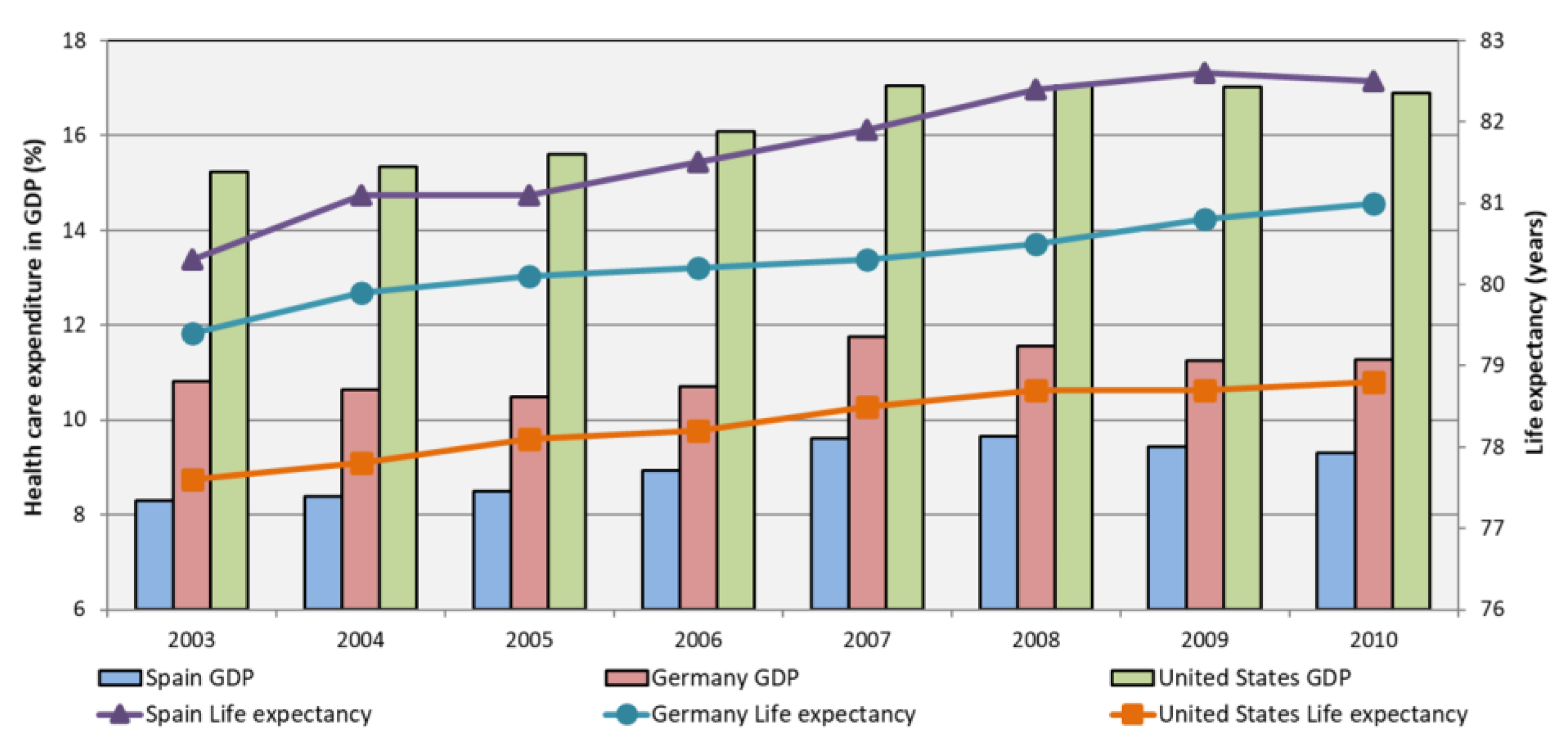
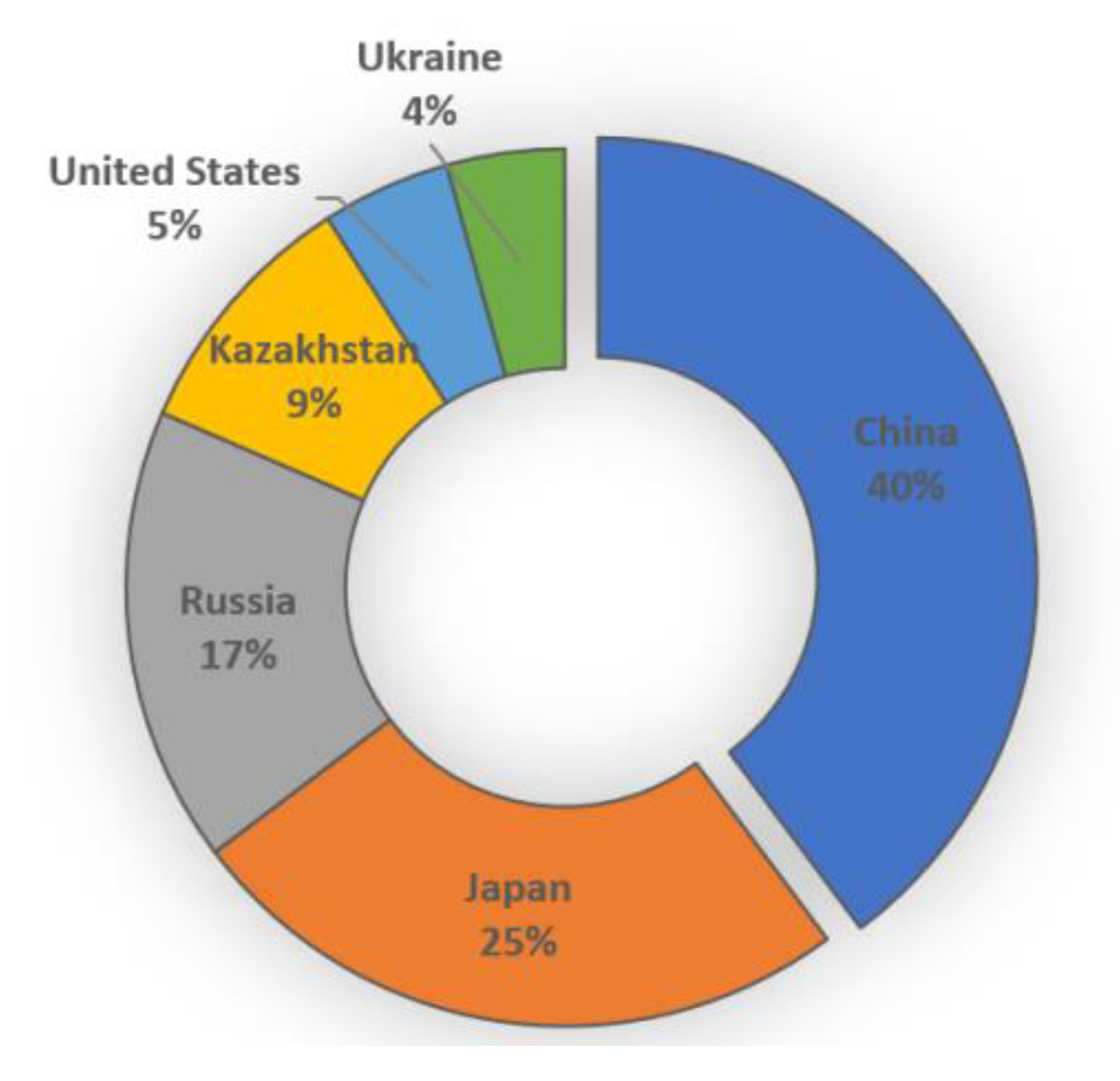
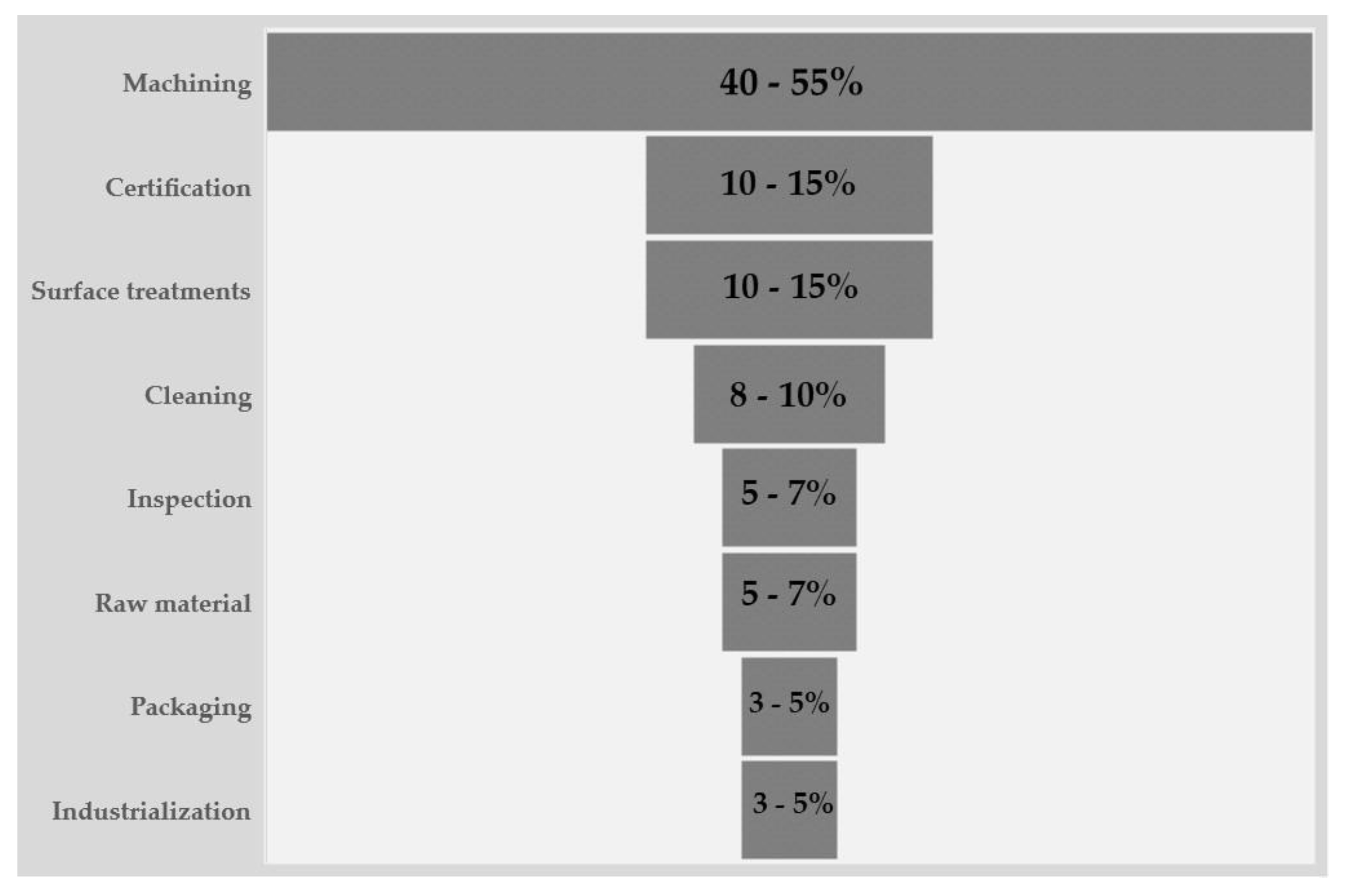
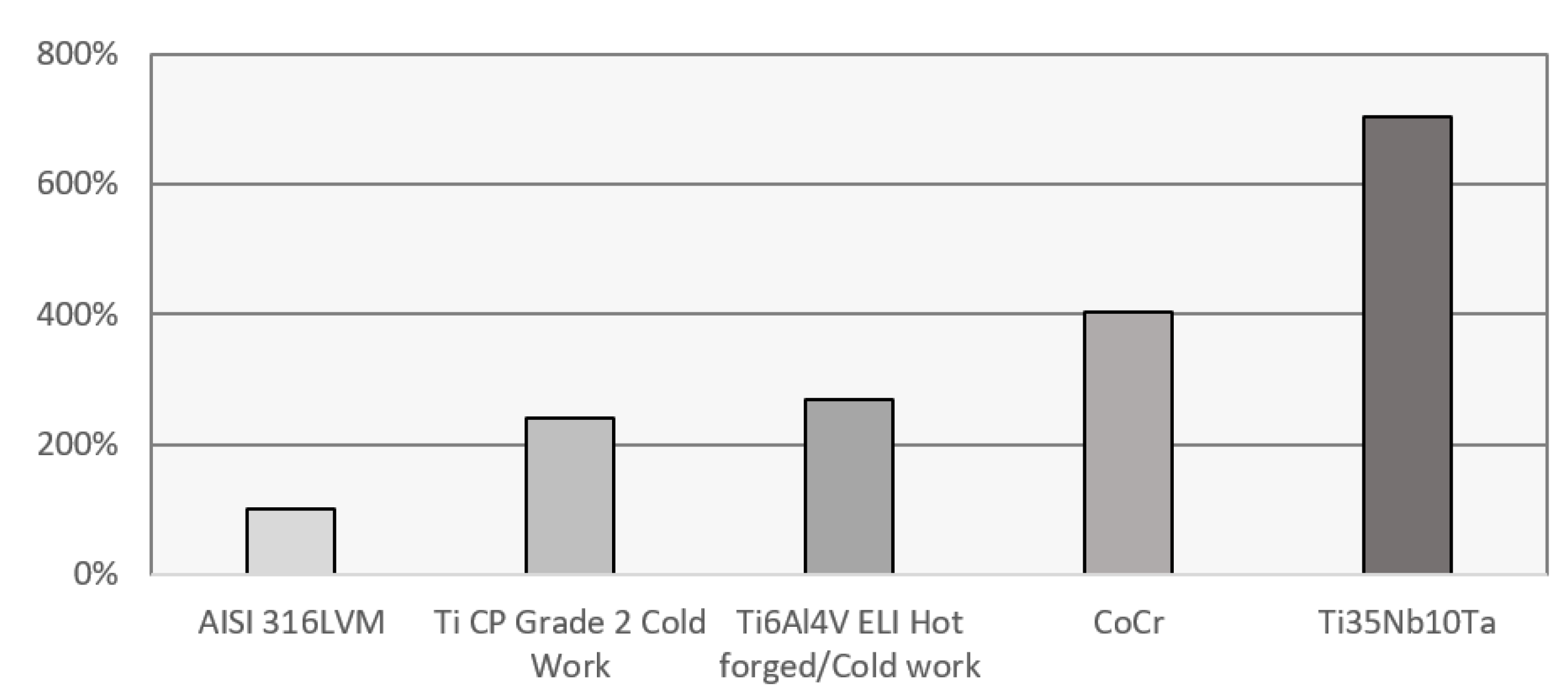
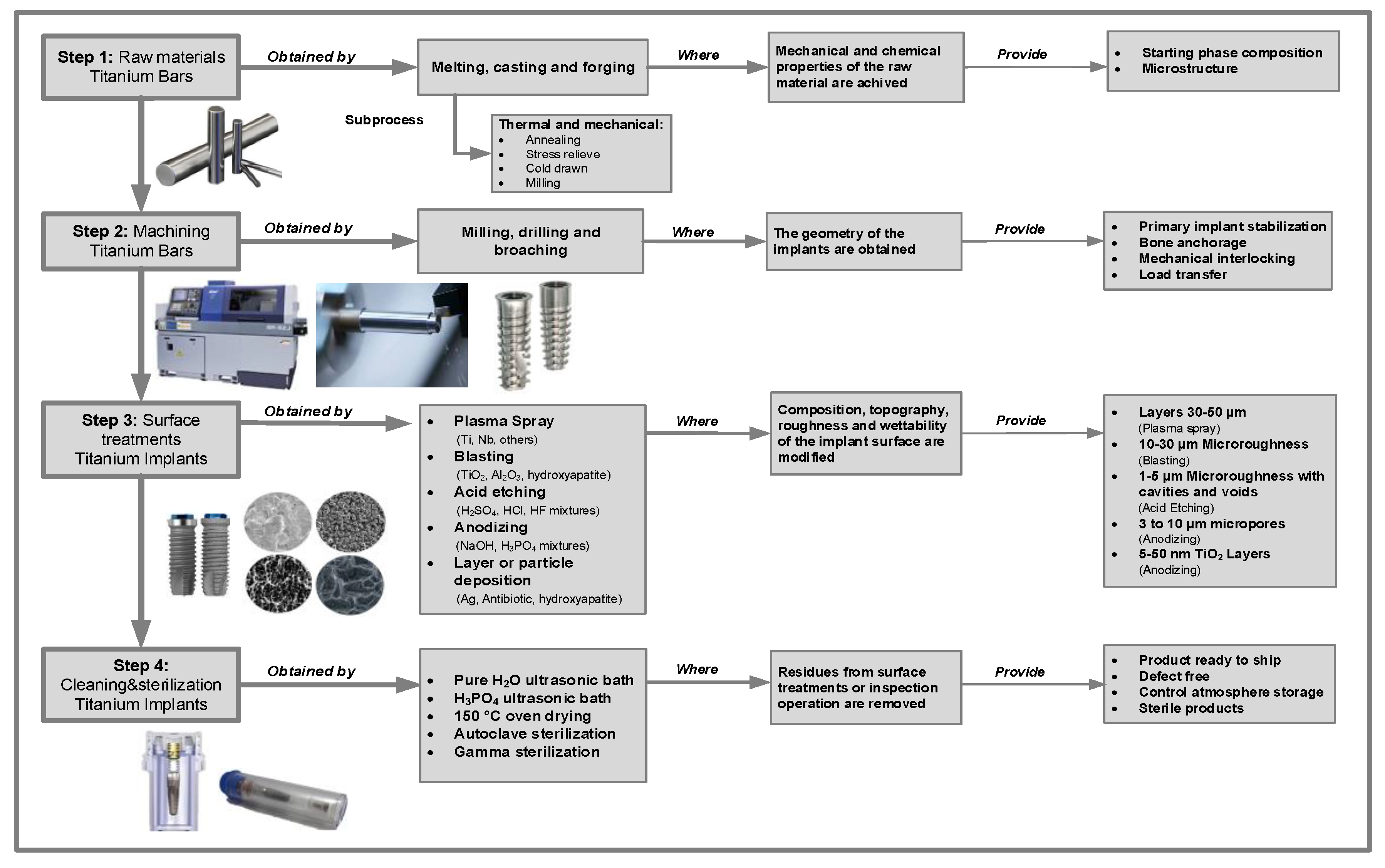

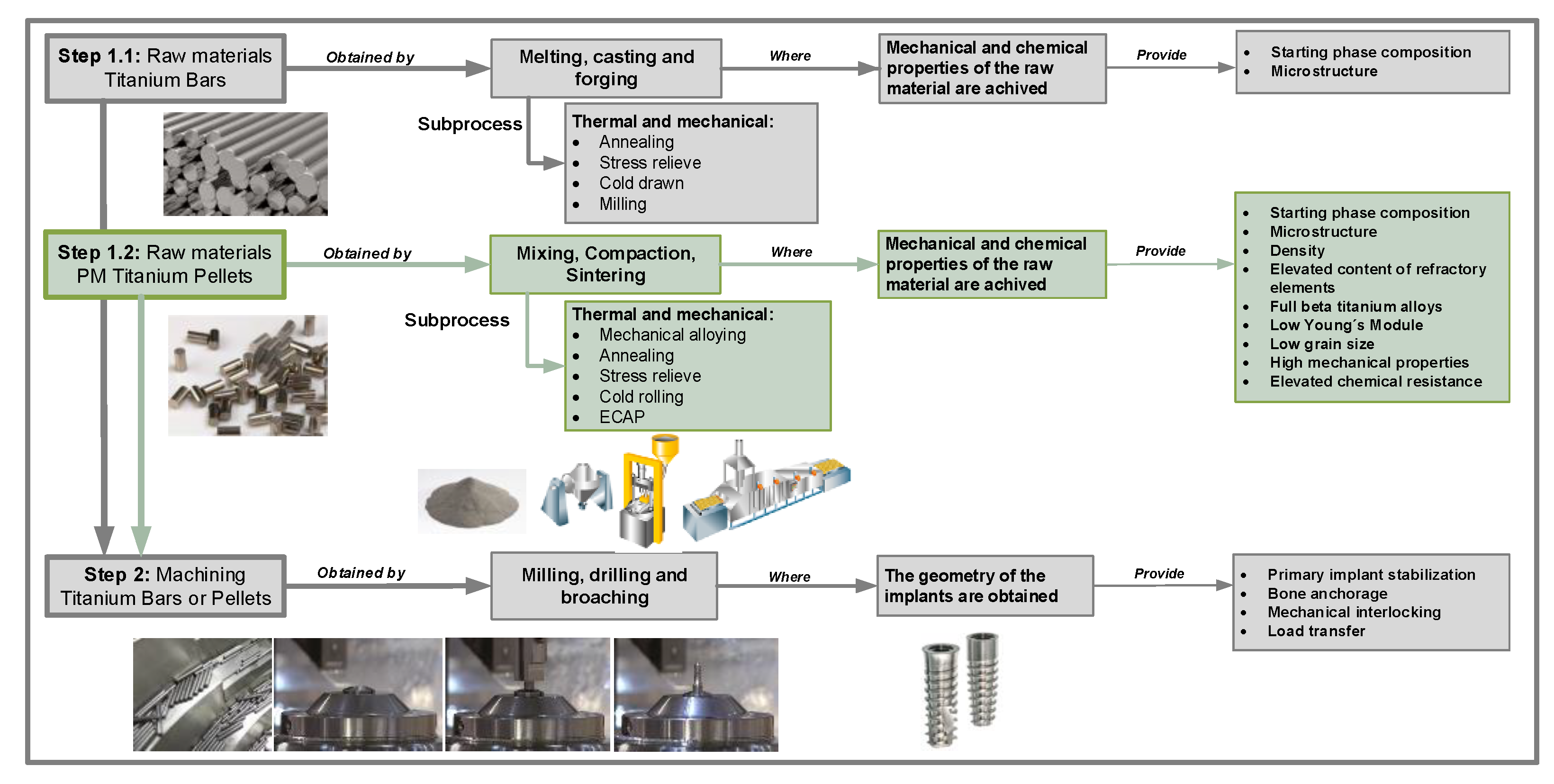
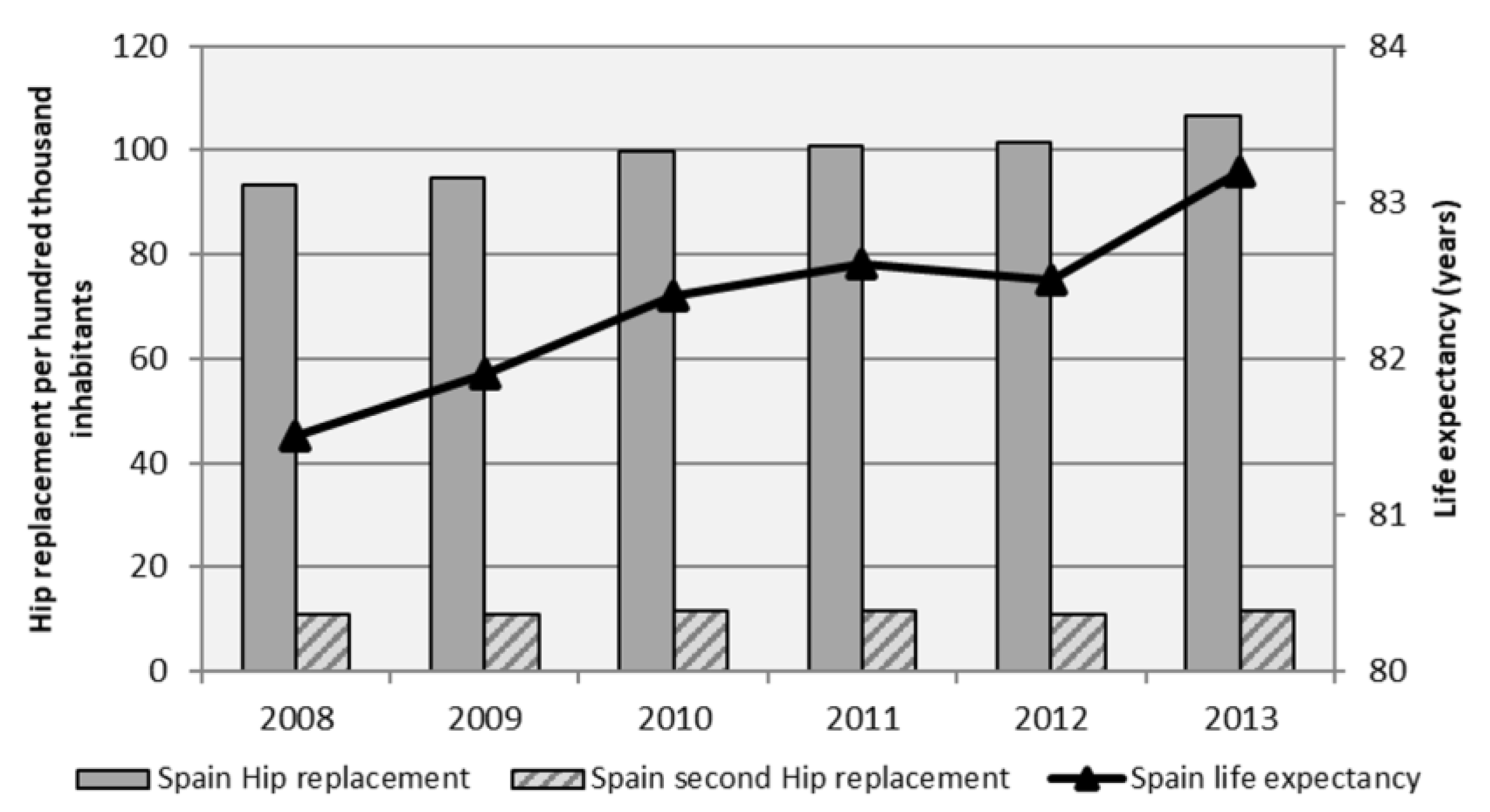

| Manufacturing Route | UTS (MPa) | Yield Strength (MPa) | Elongation (%) | Relative Density (%) |
|---|---|---|---|---|
| AMS 4928 (Min.) | 896 | 827 | 100 | 100 |
| Wrought | 965 | 896 | 14 | 100 |
| PM CIP-Sintered | 951 | 841 | 15 | 98 |
| PM HIPed | 965 | 854 | 16 | 10 |
| Manufacturing Route | UTS (MPa) | Yield Strength (MPa) | Elongation (%) | Theorical Density (%) |
|---|---|---|---|---|
| Conventional BE | 773 | 683 | 6 | 95 |
| CIP + v.s. BE | 830 | 740 | 6 | 95 |
| CHIP BE | 960 | 882 | 17 | ≈100 |
| P&S + HT + HIP | 921 | 1000 | 17 | ≈100 |
| Manufacturing Route | UTS (MPa) | Yield Strength (MPa) | Elongation (%) | Fatigue Strength at 106 Cycles |
|---|---|---|---|---|
| Conventional Ti CP4 | 700 | 530 | 25 | 340 |
| nTi ECAP + TMT | 1240 | 1200 | 12 | 620 |
| Annealed Ti6Al4V ELI | 940 | 840 | 16 | 530 |
Disclaimer/Publisher’s Note: The statements, opinions and data contained in all publications are solely those of the individual author(s) and contributor(s) and not of MDPI and/or the editor(s). MDPI and/or the editor(s) disclaim responsibility for any injury to people or property resulting from any ideas, methods, instructions or products referred to in the content. |
© 2023 by the authors. Licensee MDPI, Basel, Switzerland. This article is an open access article distributed under the terms and conditions of the Creative Commons Attribution (CC BY) license (https://creativecommons.org/licenses/by/4.0/).
Share and Cite
Lario Femenia, J.; Poler Escoto, R.; Amigó Borras, V. Powder Metallurgy: A New Path for Advanced Titanium Alloys in the EU Medical Device Supply Chain. Metals 2023, 13, 372. https://doi.org/10.3390/met13020372
Lario Femenia J, Poler Escoto R, Amigó Borras V. Powder Metallurgy: A New Path for Advanced Titanium Alloys in the EU Medical Device Supply Chain. Metals. 2023; 13(2):372. https://doi.org/10.3390/met13020372
Chicago/Turabian StyleLario Femenia, Joan, Raúl Poler Escoto, and Vicente Amigó Borras. 2023. "Powder Metallurgy: A New Path for Advanced Titanium Alloys in the EU Medical Device Supply Chain" Metals 13, no. 2: 372. https://doi.org/10.3390/met13020372
APA StyleLario Femenia, J., Poler Escoto, R., & Amigó Borras, V. (2023). Powder Metallurgy: A New Path for Advanced Titanium Alloys in the EU Medical Device Supply Chain. Metals, 13(2), 372. https://doi.org/10.3390/met13020372













